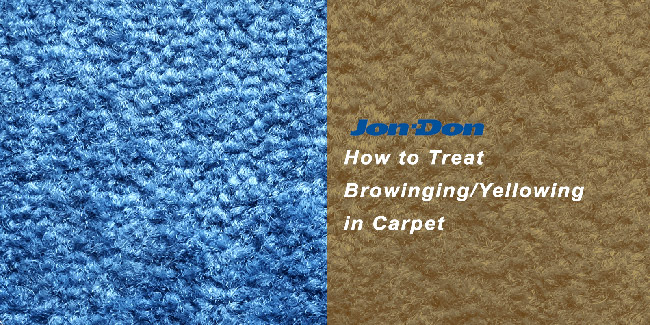
Yellowing / Browning Removal
Yellowing/browning can be caused by many factors. Sometimes it can be removed; sometimes not. Never guarantee complete removal.
The most common factors that cause yellowing are:
- Over-wetting or High Alkalinity:
Usually caused by technician error. Over-wetting can also be caused by the jets being clogged or faulty vacuum hoses and cuffs. - Cellulosic Browning:
The wetting of jute backing causes cellulosic browning. This is normally found in older carpeting. The popularity of sisal, hemp, mountain grass, and even paper has seen a resurgence in browning issues. Don’t forget that many woven rugs may have a cotton or jute backing yarn and can cause browning and shrinkage. Browning is also very prevalent in all types of cellulosic fabrics, such as cotton, linen, rayon, and viscose. - BHT in Carpet Cushion:
BHT was used as an antioxidant in the manufacture of rebond cushion. When stain-resist carpet came into existence many yellowing discolorations appeared especially after cleaning. It was traced back to the cushion and pressure from the mills put an end to it. The kind of yellowing is noticeable because it is a VERY BRIGHT canary or legal pad yellow. - Formaldehyde:
While this has been stated as a cause of browning and yellowing in carpet, it has not been used in the manufacture of carpet in over 25 years. Sometimes old information keeps being spread.
The Solution: Basic Method – Cellulosic Browning:
- With a pump-up sprayer, apply Matrix Target Tannin Stain Remover undiluted. Apply as lightly as possible to take care of the problem. Over applying can cause re-browning.
- Work in with a Grandi Groom. Reminder: the use of an acid rinse in your solution tank may prevent the browning.
Basic Method – BHT:
- Dilute Citric Acid at 8-10 tablespoons per gallon of hot water.
- Using a pump-up sprayer (or trigger sprayer for small areas), lightly mist the Citric Acid solution. Do this as lightly as possible.
- Once the area is dry, vacuum it aggressively. Citric Acid dries like fine sand and can be troublesome to vacuum.
Warning: Always test materials for colorfastness, follow label directions, and never mix products unless specified in the label directions. Each situation reacts differently and results may vary.
We pay the shipping charge, including hazardous material fees, on this item. There's no catch. No "buy this to get that" requirement.
Note: If your order contains items that are not eligible for free shipping, your order total will include our competitive shipping rates for those non-eligible items only. This shipping policy only applies to orders shipped within the Contiguous U.S.

